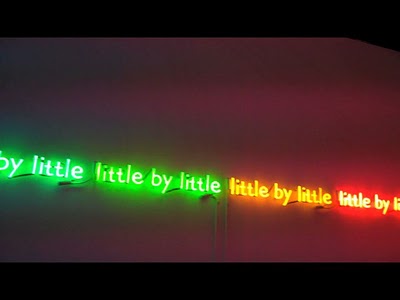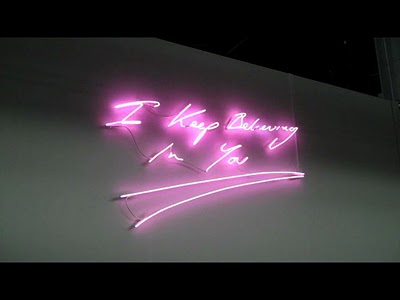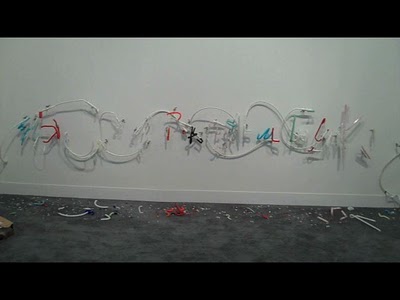 Seong Chun, Untitled Without End
Seong Chun, Untitled Without End
Artists were doing so much with paper beyond collage, and I was really impressed with how malleable the typically flat medium was in the hands of artists like Seong Chun, above and below. Her other works on view at Pulse created similarly geometric forms whose shape belied their delicateness and intricacy. They seem obsessive and painstaking, even more so when I learned the artist prints the words onto the paper herself.
 Seong Chun, detail
Seong Chun, detail
While trend sounds like group think, what artists do with this material is anything but. I wasn’t sure if William Daniel’s sculpture was paper when I first saw it because it is quite perfect and precise. It looks like it was taken from the chapel of an Italian church, and I enjoy how it plays with our perceptions of reality and materiality, and ultimately in its memento mori subject how it tackles death with something as unsubstantial as paper.
 William Daniels, Vase of Flowers in a Window Niche, 2004
William Daniels, Vase of Flowers in a Window Niche, 2004
It’s hard to get a sense of the mass created in this collage by Francis Stark, which takes up surprising volume. In its awkward, gawky way, it builds up into a Frankenstein lady of beauty.
 Francis Stark, Not Yet Titled, 2010
Francis Stark, Not Yet Titled, 2010
The groups of works below from
Abigail Reynold‘s Universal Now series are probably my favorite work of cut collage. Her collages enmesh found photographs of landmarks and monuments that were taken from a similar vantage point at different points in time.
 Abigail Reynolds, Installation View at Armory
Abigail Reynolds, Installation View at Armory
It creates an interesting interplay between times, and visually the flipped up edges of paper make one examine the work from multiple angles. Overall it plays with geometric lines in three instead of two dimensions–sharing a quality I appreciated in Seong Chun’s work. Here a photograph from 1989 is underlying a photo from 1991.
 Abigail Reynolds, Post Office Tower 1989/1999, 2009
Abigail Reynolds, Post Office Tower 1989/1999, 2009On the less than interesting side of this paper collaging fever…I’ve seen an inordinate amount of Victoriana collages, in general and during the fairs, often tinting and/or cutting old Victorian engravings to create fantastic scenes. Such simplistic collage would be more interesting with a less trite subject.
 Ruth Marten, Gathering
Ruth Marten, Gathering
 Seong Chun, Untitled Without End
Seong Chun, Untitled Without End Francis Stark, Not Yet Titled, 2010
Francis Stark, Not Yet Titled, 2010
 Abigail Reynolds, Installation View at Armory
Abigail Reynolds, Installation View at Armory











